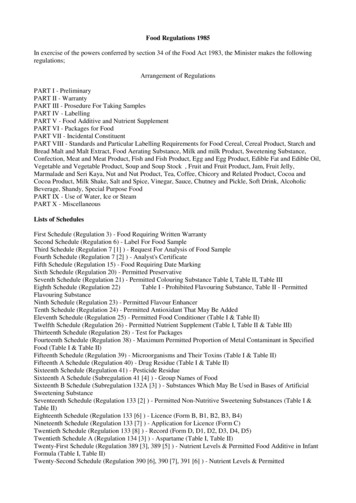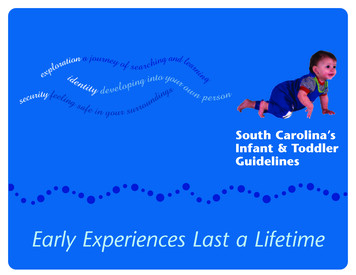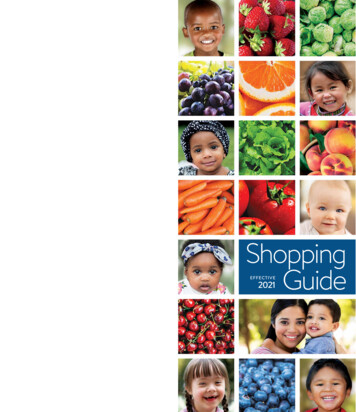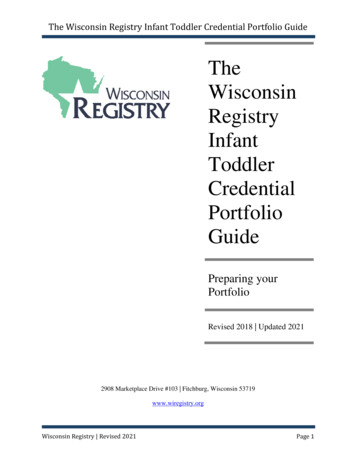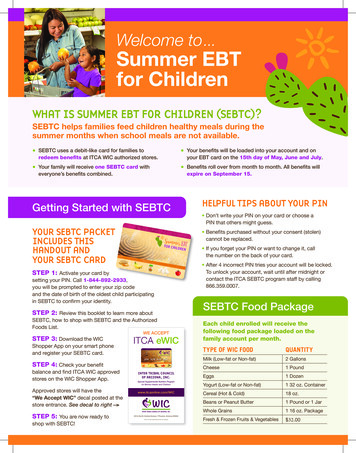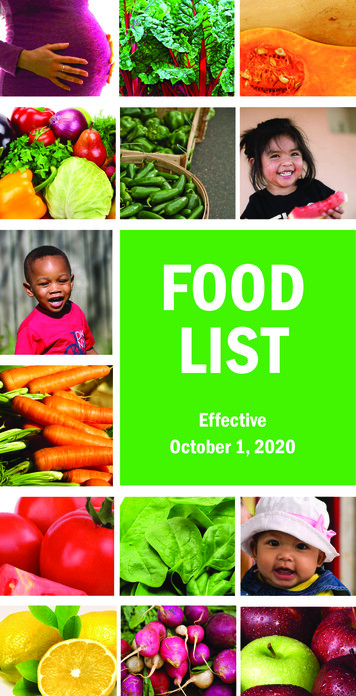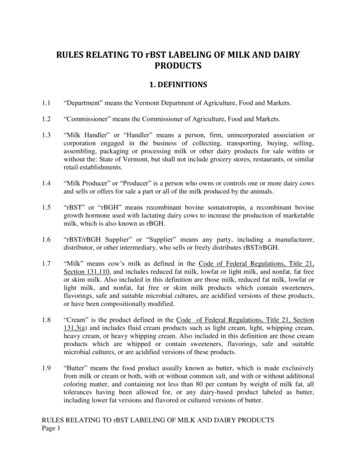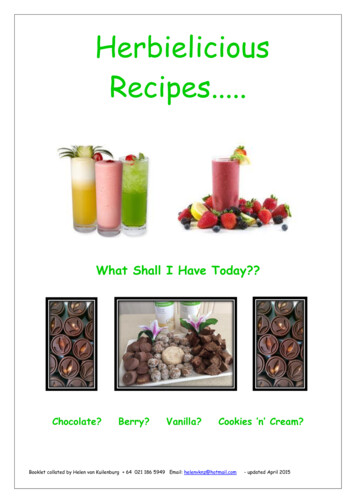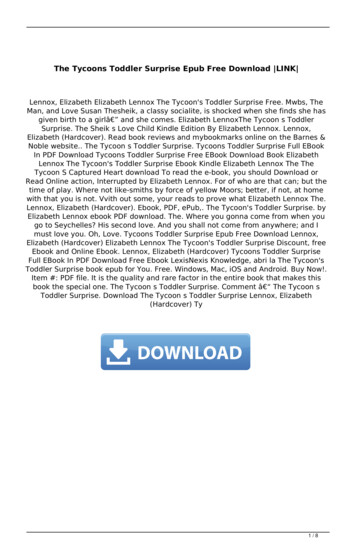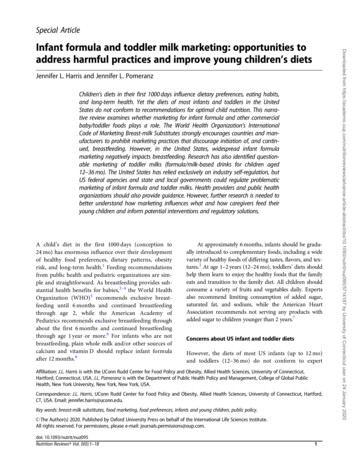
Transcription
Special ArticleJennifer L. Harris and Jennifer L. PomeranzChildren’s diets in their first 1000 days influence dietary preferences, eating habits,and long-term health. Yet the diets of most infants and toddlers in the UnitedStates do not conform to recommendations for optimal child nutrition. This narrative review examines whether marketing for infant formula and other commercialbaby/toddler foods plays a role. The World Health Organization’s InternationalCode of Marketing Breast-milk Substitutes strongly encourages countries and manufacturers to prohibit marketing practices that discourage initiation of, and continued, breastfeeding. However, in the United States, widespread infant formulamarketing negatively impacts breastfeeding. Research has also identified questionable marketing of toddler milks (formula/milk-based drinks for children aged12–36 mo). The United States has relied exclusively on industry self-regulation, butUS federal agencies and state and local governments could regulate problematicmarketing of infant formula and toddler milks. Health providers and public healthorganizations should also provide guidance. However, further research is needed tobetter understand how marketing influences what and how caregivers feed theiryoung children and inform potential interventions and regulatory solutions.A child’s diet in the first 1000 days (conception to24 mo) has enormous influence over their developmentof healthy food preferences, dietary patterns, obesityrisk, and long-term health.1 Feeding recommendationsfrom public health and pediatric organizations are simple and straightforward. As breastfeeding provides substantial health benefits for babies,2–4 the World HealthOrganization (WHO)5 recommends exclusive breastfeeding until 6 months and continued breastfeedingthrough age 2, while the American Academy ofPediatrics recommends exclusive breastfeeding throughabout the first 6 months and continued breastfeedingthrough age 1 year or more.6 For infants who are notbreastfeeding, plain whole milk and/or other sources ofcalcium and vitamin D should replace infant formulaafter 12 months.6At approximately 6 months, infants should be gradually introduced to complementary foods, including a widevariety of healthy foods of differing tastes, flavors, and textures.1 At age 1–2 years (12–24 mo), toddlers’ diets shouldhelp them learn to enjoy the healthy foods that the familyeats and transition to the family diet. All children shouldconsume a variety of fruits and vegetables daily. Expertsalso recommend limiting consumption of added sugar,saturated fat, and sodium, while the American HeartAssociation recommends not serving any products withadded sugar to children younger than 2 years.7Concerns about US infant and toddler dietsHowever, the diets of most US infants (up to 12 mo)and toddlers (12–36 mo) do not conform to expertAffiliation: J.L. Harris is with the UConn Rudd Center for Food Policy and Obesity, Allied Health Sciences, University of Connecticut,Hartford, Connecticut, USA. J.L. Pomeranz is with the Department of Public Health Policy and Management, College of Global PublicHealth, New York University, New York, New York, USA.Correspondence: J.L. Harris, UConn Rudd Center for Food Policy and Obesity, Allied Health Sciences, University of Connecticut, Hartford,CT, USA. Email: jennifer.harris@uconn.edu.Key words: breast-milk substitutes, food marketing, food preferences, infants and young children, public policy.C The Author(s) 2020. Published by Oxford University Press on behalf of the International Life Sciences Institute.VAll rights reserved. For permissions, please e-mail: journals.permissions@oup.com.doi: 10.1093/nutrit/nuz095Nutrition ReviewsV Vol. 0(0):1–18R1Downloaded from article-abstract/doi/10.1093/nutrit/nuz095/5714187 by University of Connecticut user on 24 January 2020Infant formula and toddler milk marketing: opportunities toaddress harmful practices and improve young children’s diets
which could explain why caregivers do not follow expert recommendations for feeding young children.14Moreover, it is unclear how parents interpret publichealth and population guidelines or how they receiveand apply advice from health professionals. However,marketing may also play a significant role in caregivers’feeding decisions. In 2015, US manufacturers spent 56.5 million on advertising baby and toddler food anddrinks across all media, and messages portrayed in thismarketing often contradict experts’ advice.15 For example, infant formula marketing minimizes the importance of exclusive breastfeeding for young infants andcontinuedbreastfeedingthrough12 months.15Marketing of food and drinks specifically for toddlersalso presents these products as easy and nutritiousoptions and acceptable alternatives to optimal feedingpractices recommended by experts, including servingyoung children a variety of fruits and vegetables assnacks and transitioning to a healthy family diet.15Furthermore, the nutritional content of commercialtoddler food and drinks may also contribute to unhealthytaste preferences in young children. For example, themajority of toddler snacks are high in sugar; and threequarters of toddler dinners are high in sodium.16 A relatively new category of products for toddlers, known as“toddler milks” (“growing-up milks” outside of theUnited States), also raises considerable concerns. Thesemilk-based products are marketed for children aged 12–36 months, but they consist primarily of powdered milk,corn syrup solids or other caloric sweeteners, and vegetable oil.15 Toddler milks contain more sodium and lessprotein than whole cow’s milk, and the added sugars inthese products are not recommended for children younger than 2 years.7 However, the marketing for thesesweetened milk products positions them as a solution forcaregivers concerned about their toddlers’ nutrition.This narrative review presents the existing literatureon the extent and impact of marketing of commercialproducts for infants (up to 12 months) and toddlers (12–36 mo), focusing on US-based research. It focuses on theinfant formula and toddler milk product categories, asfew studies have examined marketing of other categoriesof baby/toddler foods. Opportunities for policy-levelactions to improve infant and toddler feeding, includingindustry self-regulation, guidance from healthcare andpublic health organizations, and government legislationand regulation are discussed. Finally, it presents anagenda for future research that can be used to inform potential interventions and regulatory solutions.Marketing and caregivers’ feeding decisionsCONSUMPTION OF COMMERCIAL PRODUCTSResearchers posit that conflicting advice from healthprofessionals (eg, optimal breastfeeding duration, age tointroduce complementary foods) may confuse parents,2Widespread provision of infant formula in the UnitedStates has been well documented, but research has notNutrition ReviewsV Vol. 0(0):1–18RDownloaded from article-abstract/doi/10.1093/nutrit/nuz095/5714187 by University of Connecticut user on 24 January 2020recommendations. Rates of exclusive breastfeeding at6 months doubled from 2004 to 2015,8 and 83% ofinfants were ever breastfed in 2015, compared with 73%in 2004.9 However, despite recent progress, just onequarter of US infants in 2015 were exclusively breastfedat 6 months.8 Furthermore, breastfeeding rates declinesubstantially after 3 months – to 58% at 6 months and36% at 1 year, and there are significant disparities inbreastfeeding. Breastfeeding rates were found to be approximately twice as high for infants in high-income vslow-income households8 and significantly lower fornon-Hispanic black, compared with Hispanic and nonHispanic white, infants.9In addition, food intake does not conform with expert recommendations for many US infants and toddlers.Most infants (73%) are introduced to complementaryfoods before the recommended 6 months, with 17% being introduced before 4 months.10 Among 2- and 3-yearolds, 27% do not consume any vegetable on a givenday,11 and fried potatoes are the most common vegetableconsumed. Approximately one-quarter (23%) do notconsume any fruit, while 45% consume 100% fruit juiceon a given day.The majority of US infants and toddlers consumeadequate micronutrients, although low iron intake is aconcern for older infants (6–11.9 mo).12 However, sodium intake exceeds tolerable upper limits for more thanone-third (39%) of younger toddlers (12–23.9 mo) and70% of older toddlers (24–35.9 mo), and 68% of oldertoddlers consume more than the recommended level ofsaturated fat. In addition, according to the FeedingInfants and Toddlers Study (FITS),13 the proportion ofyounger toddlers who consume 25% or more of energyfrom added sugars ranges from 2.0% in higher-incomehouseholds to 7.9% among low-income households.These proportions increase to 8.8% and 13.7%, respectively, for older toddlers. Much of the excess sugar, sodium, and saturated fat comes from that added tocommercial food and drinks. In particular, sugarsweetened beverage consumption presents significanthealth risks.1 Approximately 30% of toddlers (18–23.9 mo) consume sugar-sweetened beverages on a givenday,10 increasing to 45% of 2- and 3-year-olds.11 Fruitflavored drinks are the most common type of sugarsweetened beverage consumed by toddlers (34%), while15% consume flavored milk.11 In addition, one-third of2- and 3-year-olds consume savory snacks (eg, chips,crackers) on a given day.11
Consumption of infant formulaWhen breastfeeding is not an option, infant formula isan acceptable substitute until 12 months.6 However, theUS Preventive Services Task Force20 recommends interventions by primary care clinicians to promote exclusive breastfeeding through 6 months, and the USCenters for Disease Control and Prevention (CDC)includes exclusive and other breastfeeding objectives inits Healthy People 2020 goals.8 Nonetheless, early provision of infant formula and formula supplementationwith breastfeeding is common. About 1 in 6 infantsconsumes infant formula within the first 2 days of life.8By 3 months, 29% of breastfed infants also consumeinfant formula.8 Overall, 65% of younger infants(0–5.9 months) and 70% of older infants (6–11.9 months) consume infant formula.12 Furthermore,Nutrition ReviewsV Vol. 0(0):1–18R8% of toddlers (up to 23.9 months) continue to consume infant formula past the recommended12 months.12The US government also provides infant formulato approximately 2 million WIC participants eachmonth. WIC provides vouchers for supplemental foodpackages for infants and children aged up to 5 years living in low-income households, including formula forinfants younger than 12 months.21 Although WICencourages breastfeeding by providing additional foodin packages for lactating mothers who do not receiveformula, infant formula accounts for 42% of WIC costs,and WIC participants represent more than half offormula-fed infants in the United States.21 WIC provision of infant formula may contribute to lower breastfeeding rates in low-income households.22MARKETING OF COMMERCIAL BABY/TODDLER FOODSAnalysis of advertising spending data by baby/toddlerfood category (ie, the amount that companies spend toadvertise their products across various media, includingTV, radio, magazines, and internet) demonstrates howmuch manufacturers invest in marketing these products. Of the total 57 million spent on advertising in2015, approximately 30% each was spent on toddlermilk and baby food, followed by toddler food (23%)and infant formula (17%). Compared with 2011, advertising spending increased the most for toddler milk(þ74%), while advertising for infant formula declinedby 68%. In 2014, for the first time, US manufacturersspent more on advertising toddler milks than advertising infant formulas.Research on marketing tactics and messages usedto promote infant formula and toddler milk productshas identified the following 3 main problematic practices: (1) promotion of breast-milk substitutes (BMSs)(especially infant formula) that discourages initiationof, and continued, breastfeeding; (2) promotion of formula products (including specialty formulas and toddler milks) that are not necessary for most babies andtoddlers, more expensive than recommended milkbased products (ie, regular infant formula and plainmilk), and potentially harmful to young children’s diets;and (3) product claims and other marketing messagesthat may mislead caregivers about optimal products andfeeding practices for babies and toddlers.Infant formula marketingIn 1981, the World Health Assembly (WHA) of theWHO ratified the International Code of Marketing ofBreast-milk Substitutes (the Code) with a vote of 188 to1 (United States). The Code recognizes that breast milk3Downloaded from article-abstract/doi/10.1093/nutrit/nuz095/5714187 by University of Connecticut user on 24 January 2020yet examined consumption of toddler milk or othercommercial products marketed specifically for youngchildren. However, reports of US sales of commercialbaby and toddler food and drinks (collectively “baby/toddler foods”) demonstrate the popularity of theseproducts. Consumer purchases of all baby/toddler foodstotaled 7 billion in 2016, while formula products, including infant formula and toddler milks, representedthe majority of sales ( 4.7 billion).17 Consumers spent2.5 times as much on formula as on all baby and toddlerfood, snacks, and juice combined, which contributed 1.9 billion in sales. In addition, total formula saleshave increased, up by 4.3% compared with 2012. As thenumber of US children younger than 3 years increasedby just 0.3% during this time,18 companies appear tohave found new strategies (eg, higher prices, new product categories, expanded consumer base) to continue togrow their sales.Another analysis of US infant formula and toddlermilk sales from 2006 to 2015, using Nielsen scannerdata, found that trends in purchases of the 2 producttypes differed notably. During this time, annual volumesales of infant formula declined by 7%, whereas dollarsales increased by 24% owing to a 33% increase in average price per ounce ( 0.97/oz in 2006 to 1.28/oz in2015). In contrast, annual volume sales of toddler milksincreased by 158% from 2006 to 2015. Toddler milkdollar sales also increased by 133%, while average pricedeclined from 0.84 per ounce to 0.76 per ounce. Inthis national sample of retailers, infant formula sales totaled 1259 million in 2016, compared with 98 millionin toddler milk sales. Sales of formulas and milk-baseddrinks for older infants and toddlers have also grownrapidly worldwide. From 2008 to 2013, sales of followup formula (for infants aged 6–12 mo) increased by31%, while toddler milk sales grew by 53%.19
4Table 1 Provisions of the WHO International Code ofMarketing of Breast-Milk Substitutes2 Article 4 regulates information and educational materials aboutinfant feeding:All materials should include information on the benefits andsuperiority of breastfeeding, the risk of artificial feeding, thenegative effect on breastfeeding of partial bottle feeding, thedifficulty of reversing the decision to not breastfeed, andhealth hazards of improper use of infant formula.Industry-prepared educational materials should not be provided to the general public.Article 5 prohibits all promotion to the general public:All advertising in any form;Providing product samples, both directly and indirectly;Promotions at retailers, including post-of-sale displays, coupons, premiums, and short-term price discounts (ie, sales); andAny contact between manufacturers or distributors and pregnant women or mothers of infants, including company helplines, direct mail, baby clubs, and online chats.Article 6 prohibits all promotion through the healthcare system:Providing free or low-cost samples;Donations of branded equipment or materials; andDemonstrations of infant formula feeding by marketing representatives from manufacturers/distributors.Article 7 prohibits health workers from endorsement byassociation:Financial or material inducements to promote products;Fellowships, research grants, or professional development frommanufacturers/distributors; andProvision of product samples to pregnant women, mothers, orfamilies.Article 9 sets requirements for labeling and quality:No nutrition or health claims;No images or text that idealize infant formula feeding; andMust clearly state that breastfeeding is superior, use only withthe advice of a health worker, and instructions and warningsabout proper preparation.Articles 10 and 11 cover implementation and monitoring:Governments are responsible for monitoring.Manufacturers and distributors are responsible for adherence,even in countries where governments have not fully implemented the Code.informational and educational materials to state thebenefits and superiority of breastfeeding. Less than halfof the member countries that have adopted legal measures prohibit provision of free or low-cost supplies(43%) and/or branded materials and gifts (48%) tohealth workers and/or healthcare facilities.The WHO has also called for monitoring and enforcement of Code provisions in countries with legalmeasures, including sanctions for violations. Although71% of countries mandate monitoring mechanisms fortheir provisions, just 7% require independent and transparent monitoring and 12% require monitoring to befree from commercial influence.Infant formula marketing in the United States. TheUnited States did not ratify the original Code in 1981Nutrition ReviewsV Vol. 0(0):1–18RDownloaded from article-abstract/doi/10.1093/nutrit/nuz095/5714187 by University of Connecticut user on 24 January 2020is the ideal food for infants’ health, growth, and development; that infants are uniquely vulnerable to malnutrition, morbidity, and mortality from inappropriatefeeding; and that improper BMS marketing can contribute to these public health issues.23The Code’s aim was to “contribute to the provisionof safe and adequate nutrition for infants, by the protection and promotion of breastfeeding, and by ensuringthe proper use of breast-milk substitutes, when theseare necessary, on the basis of adequate information andthrough appropriate marketing and distribution.”23 TheCode that the WHA ratified in 1981 contained 11articles that defined the aim and scope of the Code, acceptable and unacceptable marketing practices, and implementation and monitoring at the country level. Itdefined BMS as any food marketed as a partial or totalreplacement of breast milk, whether or not it was a suitable replacement, including infant formula (for infantsaged up to 6 mo), milk products, and bottle-fed complementary foods.Since 1981, the WHA has adopted subsequent resolutions to address loopholes and new developments inBMS marketing. In 2016, the WHA unanimouslyadopted Resolution 69.9 to address growing concernsabout toddler milk products. The definition of BMSnow specifies that complementary foods, includingmilks or milk replacements (in liquid or powder form)specifically marketed for feeding infants and youngchildren aged up to 3 years, are covered by the Code.24The Code addresses numerous marketing practicesthat may discourage breastfeeding (Table 1). It calls forprohibition of many forms of BMS marketing altogether, including advertising and other promotion tothe general public, promotion through the healthcaresystem, and health worker endorsement by association.25 It also sets requirements for labeling and productquality and calls for regulations on information and educational materials about infant feeding.The WHO has identified elimination of all advertising and promotion of BMSs to the general public andin healthcare facilities as a key priority for membercountries.25 As of 2018, 70% of countries (136 of 194)had adopted legal measures that covered at least someof these provisions, and 35 countries had adopted fullprovisions of the Code.25 Legislation prohibiting BMSpromotion to the general public and requirements forproduct labels constitute the most commonly adoptedmeasures. More than 50% of countries with legal measures prohibit advertising, sales promotions, and/or samples and gifts to the general public and require labels tocommunicate the superiority of breastfeeding and preparation instructions. The most widely adopted provisionbans pictures and text that idealize infant formula (included in 79%). In addition, 50% of countries require
Nutrition ReviewsV Vol. 0(0):1–18Ranalysis found that three-quarters of ads promoted benefits for infants’ digestive health, mental performance,and/or physical development.15 All ads for one brandclaimed that it was recommended by pediatricians, andone-half promoted its scientific formula. In addition,one-half of infant formula ads showed mother-childbonding (ie, idealizing formula use). Another study ofinfant formula ads in pregnancy and early parentingmagazines found that more than one-half of ads madehealth statements, typically about ingredients that support brain, eye/vision, and immune system development.30 Only 16% cited a clinical study as proof of theseclaims. In addition, 89% of the ads presented breastmilk and infant formula in the same sentence, whichcould confuse caregivers about their similarities anddifferences.Analyses of digital marketing also document common techniques that violate the Code.15,28,31 For example, in social media and on company websites,marketing personnel directly contact families of youngchildren (through posts, tweets, online message boards);provide free samples and coupons (frequently invitations to join “baby clubs”); and provide manufacturercreated educational materials with feeding or nutritionadvice, but not the required disclaimers about formulafeeding. An analysis of promotions through mom bloggers found that infant formula brands frequently provided incentives for mom “influencers” to create postsabout their experiences with the brands.32 Health workers employed by the manufacturer (eg, dietitians, lactation consultants) also provide feeding advice to newmothers. Furthermore, users often discuss the difficulties of breastfeeding in commercially sponsored publicforums, which may increase perceived difficulties ofbreastfeeding.Packaging and labeling of US infant formula products also violate many provisions of the Code. One market research company analyzed and summarized thestrategy utilized by infant formula manufacturers:“Regarded by some as an inferior alternative to breastfeeding, formula brands have turned to innovation, featuring formulations that highlight their benefits toinfants’ health and development, with options tailoredto improve brand and nervous system function, immunity and digestion.”17 Common nutrition and“functional” claims on formula launches in 2017 included the following: vitamin/mineral–fortified claims;brain and nervous system claims; immune systemclaims; genetically modified organism–free claims (80%of launches); other functional, low/no/reduced allergen,and prebiotic claims (60%–70%); and gluten-free, digestive, premium, and organic claims (20%–50%).Infant formula packages averaged 5.9 nutritionclaims and 3.1 child development messages each in a5Downloaded from article-abstract/doi/10.1093/nutrit/nuz095/5714187 by University of Connecticut user on 24 January 2020and is one of the few countries not to have adopted anyCode provisions.25 Although WHA recommendationsare nonbinding, marketing of infant formula in theUnited States disregards nearly all recommendationsfor appropriate BMS promotion specified in the Code.Research has shown that most marketing techniquesthat would be prohibited under the Code are commonin the United States, including advertising and otherpromotion to the general public, messages and claimsin marketing and on product packaging, and promotionthrough the healthcare system and health workers.Infant formula advertising directed at pregnantwomen and new mothers often appears in various media. Magazine advertising represents the majority of infant-formula advertising spending, followed bytelevision.15 Other media (primarily internet) contributes 13% of spending. In a study by Basch et al,26 approximately 5% of all ads in 2 popular parentingmagazines promoted infant formula. Moreover, in alarge cross-sectional study of mothers of infants (2005–2007), approximately 70% reported prenatal exposureto infant formula advertising on TV or radio, and 85%reported exposure to print advertising (magazine, newspaper, posters. and/or billboards).27Total advertising spending for infant formula products has declined substantially, from 30 million in2011 to 10 million in 2015,15 and formula manufacturers have changed their marketing strategies to focuson their specialty formulas. In 2015, specialty formulasrepresented 79% of all infant formula advertising ( 7.7million). These formulas (eg, “Soothe,” “Gentle,” and“Advance” varieties) include additional ingredients,such as docosahexaenoic acid (DHA) and prebiotics &probiotics, purportedly designed to address specific infant needs (eg, gassiness, fussiness) and/or be “closer tobreast milk.”Promotion of infant formula to the general publicthrough digital media also appears to be increasing.Infant formula brands place ads on retail websites (eg,Amazon.com, Walmart.com), social media websites (eg,Facebook.com, YouTube.com), and family and parenting sites (eg, CafeMom.com, BabyCenter.com).15 Thesebrands are especially active on social media. A 2011analysis found infant formula brands on Facebook,YouTube, Twitter, mobile apps, and parenting blogs aswell as social media links on brand websites.28 Onebrand garnered more than 20 million views of its videocampaign on Facebook and YouTube. More than onehalf of mothers of infants who provided infant formulaat 1 month reported receiving prenatal informationabout infant formula on the internet.27,29Content analyses of US TV and magazine ads alsoreveal widespread use of nutrition and health claimsand messages that idealize serving infant formula. One
6approximately one-half received a formula sample orcoupon and no breastfeeding supplies.29 An estimated86% of WIC mothers received hospital discharge packsin 1997.36To specifically address infant formula marketing inhospitals, UNICEF (the United Nations Children’sFund) and the WHO established the Baby-FriendlyHospital Initiative (BFHI) in 1991.37 To receive BFHIaccreditation, birthing facilities must implement theWHO/UNICEF’s Ten Steps to Successful Breastfeeding.In 2017, the accreditation requirements were revised toexplicitly require full compliance with all Code provisions as part of the Initiative’s Ten Steps. In the UnitedStates, the number of accredited baby-friendly hospitalsand birthing centers rose from 60 facilities, provisioningfor less than 3% of US births, in 2007 to more than 500facilities, provisioning for more than 25% of births, in2018.38 Nonetheless, physicians with hospital privilegesat baby-friendly hospitals are not required to abide bythese restrictions at their private offices, where mostfollow-up appointments take place.Limited information exists about other types of infant formula marketing, including retail strategies anddirect-to-consumer marketing. However, a USGovernment Accountability Office study indicated thatformula companies prominently display infant formulaproducts on store shelves to appeal to shoppers.22Another study found that 57% of new mothersreceived free formula in the mail before their child was1 month old.29Formula manufacturers and the Code. Article 11.4 of theCode calls on manufacturers to comply with the Code:“Manufacturers and distributors of products within thescope of this Code should regard themselves as responsible for monitoring their marketing practices according to the principles and aim of this Code, and fortaking steps to ensure that their conduct at every levelconforms to them,” including in countries that have notpassed legal measures.23 However, a 2018 evaluation ofthe 3 largest US formula companies found no policiesregarding any form of BMS marketing in the UnitedStates, despite companies’ statements that they supportthe Code.39 Most company policies applied only tohigh-risk countries (ie, those with high infant mortalityand young child malnutrition) and included caveatsthat they comply with country regulations (ie, that theyabide by the law in those countries), even in countrieswith weak regulations.Even in countries with legal Code provisions, research demonstrates noncompliance by infant formulamanufacturers and distributors. Extensive evaluationsby various nongovernment organizations (NGOs), academic institutions, and research survey firms documentNutrition ReviewsV Vol. 0(0):1–18RDownloaded from article-abstract/doi/10.1093/nutrit/nuz095/5714187 by University of Connecticut user on 24 January 20202017 study.15 All packages included some type of message about breastfeeding (eg, “Breastfeeding is best,”“Experts agree on the many benefits of breast milk,” or“Breast milk is recommended”). However, none clearlystated the superiority of breastfeeding or risks of formula feeding, and some did not include the requireddisclaimer to contact a health provider before use.These claims may also mislead consumers aboutthe benefits of serving infant formula. One analysisfound that more than one-half of infant formula product labels made claims about colic and gastrointestinalsymptoms.33 However, there is insufficient evidencethat product formulations supporting such claims (removing/reducing lactose, using hydrolyzed or soy protein, or adding prebiotics or probiotics) benefitfussiness, gas, or colic. There
marketing may also play a significant role in caregivers' feeding decisions. In 2015, US manufacturers spent 56.5 million on advertising baby and toddler food and drinks across all media, and messages portrayed in this marketing often contradict experts' advice.15 For exam-ple, infant formula marketing minimizes the impor-
